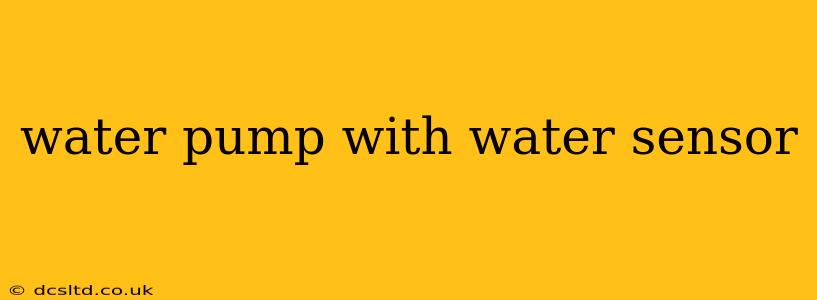A water pump with a water sensor offers a smart and efficient solution for various applications, from automated watering systems to industrial processes. This system combines the functionality of a water pump with the intelligence of a sensor, enabling automated control based on real-time water level detection. This comprehensive guide delves into the intricacies of this technology, exploring its applications, benefits, and key considerations.
What is a Water Pump with a Water Sensor?
A water pump with a water sensor is a system where a sensor monitors the water level in a tank, reservoir, or other container. This sensor then sends signals to a control unit, which, in turn, activates or deactivates the water pump based on pre-programmed parameters or real-time water level readings. This automation prevents overflow, ensures sufficient water supply, and optimizes water usage. The sensor itself can utilize various technologies, such as float switches, ultrasonic sensors, or capacitive sensors, each with its own advantages and limitations.
How Does a Water Pump with a Water Sensor Work?
The system's functionality relies on the interplay between the water sensor and the water pump. The sensor continuously monitors the water level. When the water level falls below a predetermined threshold, the sensor signals the control unit to start the pump, drawing water into the reservoir. Conversely, when the water level reaches a maximum level, the sensor signals the pump to stop, preventing overflow. This entire process is automated, minimizing manual intervention and ensuring efficient water management. Modern systems often incorporate features like adjustable thresholds, low-water alarms, and remote monitoring capabilities.
What are the Different Types of Water Sensors Used?
Several types of water sensors can be integrated into a water pump system. The choice depends on factors like application, budget, and required accuracy:
- Float Switches: These are simple, cost-effective sensors that use a float to detect water level changes. They are mechanically activated and are suitable for applications requiring basic on/off control.
- Ultrasonic Sensors: These sensors measure the time it takes for an ultrasonic pulse to reflect off the water surface, determining the water level. They offer non-contact measurement and are suitable for various applications, including those with opaque liquids.
- Capacitive Sensors: These sensors measure changes in capacitance to determine the water level. They are generally more accurate and reliable than float switches but may be more expensive.
What are the Advantages of Using a Water Pump with a Water Sensor?
The integration of a water sensor significantly enhances the functionality and efficiency of a water pump system:
- Automated Water Management: Eliminates the need for manual monitoring and intervention, saving time and effort.
- Prevent Overflow: Prevents costly and potentially damaging water overflows.
- Optimize Water Usage: Ensures efficient water usage by only pumping when needed.
- Improved Efficiency: Reduces energy consumption by avoiding unnecessary pump operation.
- Remote Monitoring: Some systems offer remote monitoring capabilities, allowing for real-time control and monitoring from a distance.
What are the Applications of Water Pumps with Water Sensors?
Water pumps equipped with sensors find applications across diverse sectors:
- Automated Irrigation Systems: Precisely control watering schedules for optimal plant growth and water conservation.
- Water Treatment Plants: Maintain consistent water levels in various tanks and reservoirs.
- Industrial Processes: Control fluid levels in manufacturing processes requiring precise fluid management.
- Aquaculture: Maintain optimal water levels in fish tanks and aquaculture systems.
- Domestic Water Management: Ensure sufficient water supply in water tanks and prevent overflows.
How to Choose the Right Water Pump with Water Sensor?
Selecting the right system requires careful consideration of several factors:
- Water Source and Capacity: Determine the volume of water to be pumped and the source of the water.
- Water Level Range: Define the minimum and maximum water levels to be monitored.
- Accuracy Requirements: Choose a sensor with appropriate accuracy based on the application requirements.
- Power Requirements: Consider the power requirements of both the pump and the sensor.
- Environmental Conditions: Assess the environmental conditions (temperature, humidity, etc.) to ensure sensor compatibility.
What are the Maintenance Requirements for a Water Pump with a Water Sensor?
Regular maintenance is essential to ensure optimal performance and longevity:
- Regular Cleaning: Clean the sensor regularly to prevent debris from interfering with its operation.
- Check for Leaks: Regularly check for leaks in the pump and plumbing system.
- Calibration: Calibrate the sensor periodically to ensure accurate readings.
- Inspect Wiring and Connections: Regularly inspect the wiring and connections for any damage or loose connections.
By understanding the functionality, applications, and maintenance requirements of water pumps with water sensors, you can make informed decisions to optimize water management in your specific application. This technology offers a cost-effective and efficient way to automate water control, leading to improved efficiency and resource conservation.
